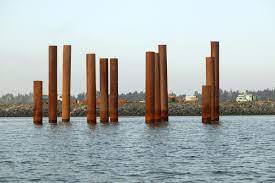Water piling, also known as water-assisted piling or hydraulic piling, represents an innovative and sustainable approach to foundation construction. This method utilizes the force of water to drive piles into the ground, offering numerous advantages over traditional piling techniques. In this article, we will delve into the principles, benefits, and applications of water piling, highlighting its potential to revolutionize the construction industry and contribute to sustainable building practices.
Principles of Water Piling:
- Hydraulic Pressure: Waters piling relies on hydraulic pressure to drive piles into the ground. A specialized hydraulic hammer attached to the piling rig utilizes the force generated by pressurized water to force the pile into the soil. This method is not only effective but also environmentally friendly, as it minimizes the use of heavy machinery and eliminates the need for conventional pile driving methods that can cause soil disturbance and noise pollution.
- Reduced Vibrations: Unlike traditional pile driving methods that can generate significant vibrations, water piling minimizes ground vibrations. This reduction in vibrations is beneficial in urban environments where nearby structures and sensitive equipment could be adversely affected by the impact of pile driving. The lower environmental impact makes waters piling an attractive option for projects in noise-sensitive areas.
Benefits of Water Piling:
- Environmentally Friendly: Waters piling contributes to environmental sustainability by minimizing the ecological footprint associated with traditional piling methods. The reduced noise, vibrations, and soil disturbance make it a greener alternative, aligning with the increasing emphasis on eco-friendly construction practices.
- Cost-Effective: While the initial investment in waters piling equipment may be higher, the overall cost of construction can be reduced due to faster installation times and fewer environmental mitigation measures. Additionally, the versatility of waters piling allows for its application in a variety of soil conditions, potentially eliminating the need for soil improvement techniques.
- Versatility in Soil Conditions: Water piling demonstrates versatility in handling different soil types. Whether it is cohesive or granular soil, the hydraulic pressure generated by water piling can effectively drive piles into the ground. This adaptability makes it a valuable technique for construction projects in diverse geographical locations.
- Increased Construction Speed: The efficiency of waters piling contributes to faster construction timelines. With minimal setup and dismantling times, as well as the ability to work in various weather conditions, water piling accelerates the foundation installation process. This can be particularly advantageous in projects with tight schedules.
Applications of Water Piling:
- Urban Construction: Waters piling is well-suited for construction projects in urban areas where minimizing noise and vibrations is crucial. The reduced impact on the surrounding environment makes it an ideal choice for building foundations, bridges, and other structures in densely populated areas.
- Infrastructure Projects: Large-scale infrastructure projects, such as highways, bridges, and tunnels, can benefit from waters piling due to its speed and efficiency. The reduced environmental impact also aligns with the growing emphasis on sustainable infrastructure development.
- Waterfront Structures: Waters piling finds particular relevance in the construction of waterfront structures, such as docks, piers, and marine terminals. Its ability to work in various soil conditions, including those near water bodies, makes it a valuable technique for projects in coastal and marine environments.
Conclusion:
Water piling emerges as a promising and sustainable solution in the realm of foundation construction. Its environmentally friendly nature, reduced vibrations, and versatility in soil conditions position it as a key player in the drive towards more sustainable building practices. As the construction industry continues to prioritize eco-friendly methods, waters piling stands out as a technology that not only meets current demands but also holds the potential to shape the future of foundation construction.

